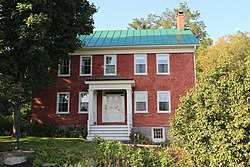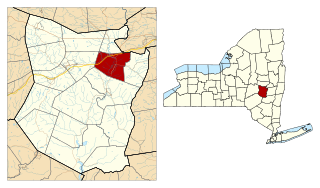
Schoharie is a town in Schoharie County, New York. The population was 3,299 at the 2000 census.

Poquetanuck is a village in the town of Preston, Connecticut, located near the banks of a bay known as Poquetanuck Cove that opens to the Thames River. The village includes the National Register of Historic Places (NRHP)-listed Poquetanuck Village Historic District.

This is a list of the National Register of Historic Places listings in Dakota County, Minnesota. It is intended to be a complete list of the properties and districts on the National Register of Historic Places in Dakota County, Minnesota, United States. Dakota County is located in the southeastern part of the U.S. state of Minnesota, bounded on the northeast side by the Upper Mississippi River and on the northwest by the Minnesota River. The locations of National Register properties and districts for which the latitude and longitude coordinates are included below, may be seen in an online map.
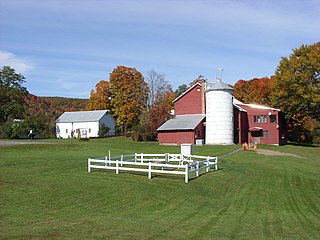
The Lansing Manor House was built in 1819 by John Lansing, Jr. for his daughter and son-in-law, Jacob Livingston Sutherland. John Lansing, Jr. represented New York as a delegate to the Constitutional Convention in 1787, and the state's Ratification Convention in 1788.
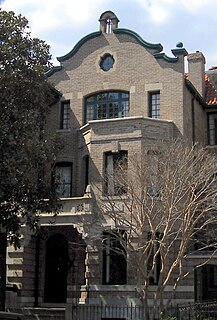
The L. Ron Hubbard House, also known as the Original Founding Church of Scientology, is a writer's house museum and former Scientology church located at 1812 19th Street NW in the Dupont Circle neighborhood of Washington, D.C., United States. Public tours are given on a regular basis. The operating Founding Church is now located at 1424 16th Street for services, bookstore and classes. The home served as the residence of Scientology founder L. Ron Hubbard from 1955 until 1959, during which time he incorporated the Founding Church of Scientology and performed the first Scientology wedding. The building is a contributing property to the Dupont Circle Historic District, a neighborhood listed on the National Register of Historic Places.

Cinnamon Bay Plantation is an approximately 300-acre (1.2 km2) property situated on the north central coast of Saint John in the United States Virgin Islands adjacent to Cinnamon Bay. The land, part of Virgin Islands National Park, was added to the United States National Register of Historic Places on July 11, 1978. Archaeological excavations of the land document ceremonial activity of the Taínos, as well as historic remains of plantation ruins.

This is a list of the National Register of Historic Places listings in Crow Wing County, Minnesota. It is intended to be a complete list of the properties and districts on the National Register of Historic Places in Crow Wing County, Minnesota, United States. The locations of National Register properties and districts for which the latitude and longitude coordinates are included below, may be seen in an online map.

Big Bottom Farm is a farm in Allegany County, Maryland, USA on the National Register of Historic Places. The Greek Revival house was built circa 1845, possibly by John Jacob Smouse, and exhibits a level of historically accurate detailing unusual for the area. The property includes a late 19th-century barn and several frame outbuildings.

There are 69 properties listed on the National Register of Historic Places in Albany, New York, United States. Six are additionally designated as National Historic Landmarks (NHLs), the most of any city in the state after New York City. Another 14 are historic districts, for which 20 of the listings are also contributing properties. Two properties, both buildings, that had been listed in the past but have since been demolished have been delisted; one building that is also no longer extant remains listed.

Sternbergh House is a historic home located at Schoharie in Schoharie County, New York. It was built about 1825 is a two-story, five-bay, center entrance timber framed vernacular Federal style house. Also on the property is the 1813 grave of Abraham Sternbergh.

The George Westinghouse Jr. Birthplace and Boyhood Home is a historic home located at Central Bridge in Schoharie County, New York. The property includes two 19th-century residences, two small barns, a well house and privy, as well as the site of a combined blacksmith shop and threshing machine works. The house where Westinghouse was born was built about 1825 and is a 1 1⁄2-story, rectangular frame residence in a vernacular Greek Revival style.

The Apple Tavern in Guilderland, New York was built in 1760. It was listed on the National Register of Historic Places in 1982. The listing included four contributing buildings on a 6.3-acre (2.5 ha) area.
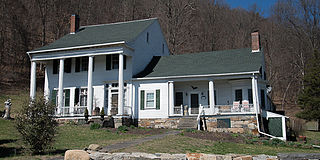
Newkirk Homestead, also known as the Newkirk-Garcia House, is a historic home located at Leeds in Greene County, New York. The original structure and basement dates to the 18th century. It is a five-bay, 1 1⁄2-story frame dwelling to which is attached a 2-story, three-bay frame addition completed in the mid-19th century. It features a Greek Revival style portico with four Doric columns, also added in the mid-19th century. Also on the property are a corn crib, two barns, and a barn foundation.

House at New Forge is a historic home located at New Forge in Columbia County, New York. It was built about 1850 and is a vernacular Greek Revival style residence. It features a two-story, projecting polygonal bay with a hipped roof and a large, deep verandah. Also on the property is a privy. The property includes the full extent of the 18th century industrial, commercial, and residential activities at Maryburgh Forges and the 19th century hamlet of New Forge. Within the property is the site of the 18th century iron forges, the site and foundation of the mid- late-19th century Livingston family manor house, the sites of several former commercial and / or residential buildings, and the site of mid-19th century grist mill, saw mill, and plaster mill.

The Twentieth Century Club is a women's social club founded in the late 19th century in Buffalo, New York. It is located at 595 Delaware Avenue, in the Delaware District neighborhood. It was the first club run by women, for women, in the United States.
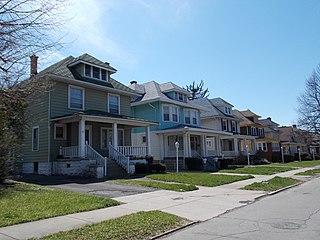
Hamlin Park Historic District is a national historic district and neighborhood located at Buffalo in Erie County, New York. The district encompasses 1,368 contributing buildings, 3 contributing sites, and 6 contributing structures in a predominantly residential section of Buffalo. The district includes a variety of residential buildings built primarily between about 1895 and 1930, and later improved through Model Cities Program grants between 1966 and 1975. It includes a variety of pattern book houses in popular architectural styles of the late-19th and early-20th century, with some interspersed Bungalow / American Craftsman style dwellings. Located in the district are the separately listed Robert T. Coles House and Studio and Stone Farmhouse. Other notable buildings include the Lutheran Church Home (1906), the former Second United Presbyterian Church (1920), and the former St. Francis DeSales Roman Catholic Church (1926).

Putnam Camp is a historic former farm and Adirondack seasonal camp and national historic district located at St. Huberts, Essex County, New York. The district encompasses 11 contributing buildings and 1 contributing structure in the Lower Camp and Upper Camp relating to the property's historic uses as a farm and later a camp. It was developed in the mid-19th century as the Beede farm and the property includes the Beede farmhouse and timber frame barn / woodshop. Later farm-related buildings include the Bungalow. The camp was established in 1875–1876 and subsequently cabins were built including the Coop, Chatterbox, Stoop, Shanty, Nursery and Parent's Assistant, Ark (1905), and the Doctor's House. The property was developed in the mid-1870s by three prominent Boston families - Bowditch, Putnam, and James, namely Henry Pickering Bowditch (1840–1911), William James (1842–1910), Charles Pickering Putnam (1844–1914), and James Jackson Putnam (1846–1918).

Christian Hess House and Shoemaker's Shop, also known as the Christian Hess Homestead and Weaver House, is a historic home and commercial building located at Schoharie, Schoharie County, New York. The house was built about 1783, and is a 1 1/2-story, banked, timber frame dwelling in a traditional New World Dutch style. A wing was added in 1977. Also on the property is a small shoemaker's shop, built about 1805. It is an "L"-shaped building with a gable roof.

German Bank is a historic building located in the Lower Main Street district of Dubuque, Iowa, United States. The city's German community was its most prominent ethnic group in the mid to late 19th century. Like many other cities in Iowa of that area it had banks that were owned by, and catered to, members of their particular immigrant communities. T.H. Thedinga, the city's first German-born mayor, started this bank in 1864 to serve immigrant Germans. In 1868 it moved from its original location on Main Street and into the former Dubuque Miners' Bank building. That building was torn down in 1901 in order to construct this one. It was designed by Dubuque architect John Spencer in partnership with Chicago architect W.G. Williamson. The three-story brick building has a highly decorative main facade composed of polished pink granite on the main floor and terra cotta on the upper two floors. Decorative elements include egg-and-dart, Greek fret, a row of small lions' heads, bay windows, scroll pediments, imperial German eagles, and a bracketed cornice with dentils. The second and third floors are dominated by four fluted, banded columns with Corinthian capitals.

The Burlington–Harmony Hill Roads Historic District encompasses a historic rural agricultural crossroads village in eastern Harwinton, Connecticut. Stretching mainly along Harmony Hill Road north of its junction with Burlington Road, it includes residential buildings dating from the mid-18th to late 19th centuries. The district was listed on the National Register of Historic Places in 1996.
